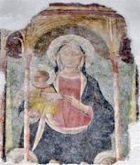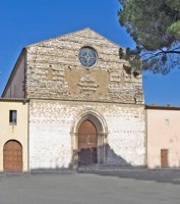
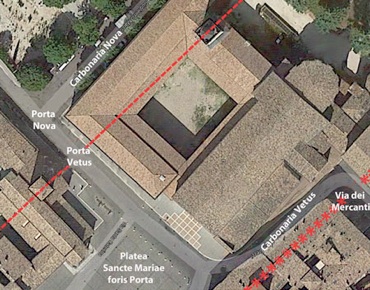
The chronicle of Bonaventura di Benvenuto recorded that, in 1285:
-
“The Friars Preachers [i.e. the Dominicans] came to Foligno [in 1285] and began the place [i.e. their convent] near the Plateam Sanctae Mariae” (my translation).
They had presumably been invited by Bishop Paparone (1265-85), who was himself a Dominican. The document in which Pope Honorius IV confirmed the transfer specified the site:
-
“...at the end of Via dei Mercanti [now Via Gramsci], near the gate and piazza of Santa Maria foris Portam [now Santa Maria Infraportas], outside the city walls, [on a site bounded by]:
-
✴the street that runs from [this piazza] to the ‘portam veterem civitatis Fulginatis’ and on to the ‘portam novam’, which stands in the carbonaria nova ...;
-
✴the carbonaria nova;
-
✴... the carbonaria vetus ... ; and
-
✴[a number of private properties]
Thus, it seems that, although the walls of ca. 1240 had been demolished by this time, the corresponding moat and the gate here (referred to as the Porta Nova) survived. So too had a gate in the earlier walls, now the Porta Vetus, although the Dominicans seem to have built their campanile on the surviving foundations of one of its towers. Since the site was now outside the city walls, it seems that the walls that must one have abutted the Porta de Petitu at the end of Via dei Mercanti had been rebuilt. (This complex topography is described in more detail in the page on the City Walls of Foligno.)
The new convent housed a studium by 1288. The future St Antoninus of Florence was among the Dominicans from Fiesole who took refuge here during period 1409-14, when the events attending the closing years of the papal schism made Fiesole unsafe for them.
Pope Pius V transferred the convent to the reformed branch of the Order in 1566.
The community was suppressed in 1799, in 1806, in 1848 and then finally and permanently in 1860.
-
✴After a chequered subsequent history, plans were made to restore the church in 1972, but these came to nothing. The roof collapsed in 1976, which brought matters to a head. The project to convert it into an auditorium began in 1982 and was completed in 1996.
-
✴The ex-convent housed the Collegio Sgariglia, a school run by the Somaschi Fathers, in the period 1928-71.
Exterior
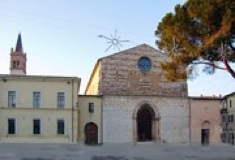
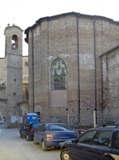
The history of the construction and decoration of the church in barely documented, but it seems to have taken place over a considerable period of time.
-
✴The present apse was begun in 1435 and was still not finished in 1474.
-
✴The campanile was built in 1483. (This campanile is in the photograph on the left. The campanile in the other photograph belongs to the adjacent Orarorio del Crocifisso.
The unfinished façade of the church in Piazza San Domenico is of pink and white stones and contains an ogival door.
Interior
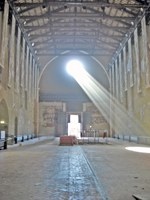
The huge church has an uncluttered nave that was designed for preaching to large congregations. A large number of altars and funerary monuments were built inside the church from the 16th century, and these obscured most of the earlier votive frescoes. A number of these that were recovered during the recent restoration are described below. The numbers in square brackets below refer to the information boards provided in the auditorium.
Maestro dell’ Abside Destra di San Francesco di Montefalco
Frescoes (ca. 1400) that are attributed to the Maestro dell’ Abside Destra di San Francesco di Montefalco include the following:
Dormition and Coronation of the Virgin [?? Cf]
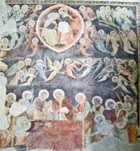
Volto Santo (early 15th century) [1L]
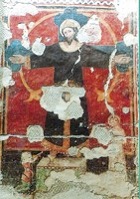
The iconography of the Volto Santo derives from a venerated wooden sculpture in the cathedral of Lucca. According to tradition, an angel guided Nicodemus as he worked on the figure, but he was seized by the fear when he came to work on the face. He fell asleep and when he awoke, the face had been miraculously completed. Bishop Gualfredo of Lucca was guided to the hidden sculpture by a dream while on pilgrimage to the Holy Land in 782. He entrusted it to a boat without a crew, and it duly arrived off the coast of Luni. A cart led by oxen took it to the church of San Frediano in Lucca, but by the next morning it had miraculously moved to the church of San Martino, which then became the site of the Duomo of Lucca. The Dominicans revered the image because Christ appeared to St Catherine of Siena as she prayed before it.)
Madonna del Latte with saints [4 Cf]

Stigmatisation of St Catherine of Siena [5 Cf]
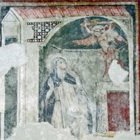
Christ in the house of Mary and Martha [7 R]
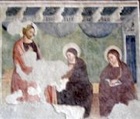
Madonna and Child with saints [14L]

Presentation at the Temple [25L]

Cola Petruccioli [20-2L]
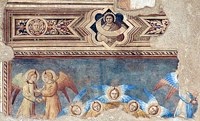
Surviving fresco fragments (late 14th century) that are attributed to Cola Petruccioli, depicted:
-
✴the Assumption of the Virgin, with a prophet above (the surviving fragment of which is illustrated here);
-
✴the Presentation at the Temple (or meeting at the Golden Gate); and
-
✴the Madonna and Child with two saints (perhaps SS Catherine of Alexandria and Dominic).
Giovanni di Corraduccio Mazzaforte
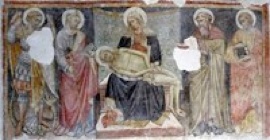
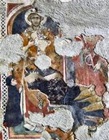
Frescoes (early 15th century) attributed to Giovanni di Corraduccio Mazzaforte include:
-
✴the Pietà with SS Michael, James, Antony Abbot and Bartholomew [3 Cf];
-
✴SS Gregory and Leonard with donor [7L] (which is painted over another fresco [8L] of the death of St Peter Martyr (see below); and
-
✴the Mystical Marriage of St Catherine [16 R], not illustrated here.
Nicolò di Liberatore [13 R]
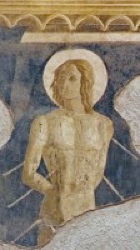
Bartolomeo di Tommaso [27L]
Unknown Artists
Death of St Peter Martyr (late 14th century) [8L]
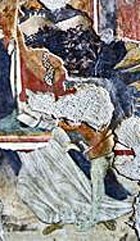
St Felician (ca. 1499) [17 R]
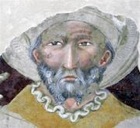
St Thomas Aquinas in Glory (early 15th century) [1 R]
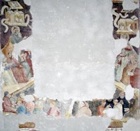
Art from the Church
The following works from San Domenico are now in the Pinacoteca Civica:
St Antony Abbot (early 15th century)
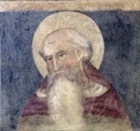
Head of a Knight (15th century)
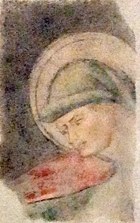
Madonna and Child and saints (late 15th century)
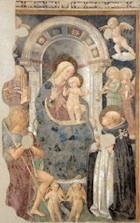
Crucifixion with saints (late 15th century)
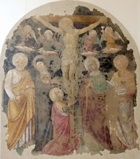
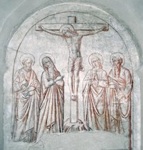
Sinopie, in situ
This damaged detached fresco, which is attributed to Pierantonio Mezzastris, came from the chapel to the right of the presbytery. It depicts the Crucifixion with the Virgin and SS John the Evangelist, Peter, Paul and the kneeling Mary Magdalene. The sinopie survives in the original location; the figures of St Mary Magdalene and of the four angels in the fresco do not appear in it, which suggests that they were later additions.
Angel of the Annunciation (late 15th century)
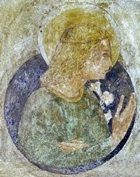
The fresco is variously to Pierantonio Mezzastris or Benozzo Gozzoli: it is almost certainly based on the cartoon that was used for Benozzo’s fresco in Narni. It has to be said, however, that there is no documentary evidence that Benozzo was ever in Foligno.
St Bartholomew (early 16th century)
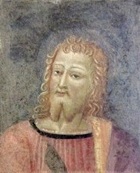
View of Foligno (1602)

Michele Faloci Pulignani documented and illustrated this long panel in his guide to Foligno (1907), when it was “near the parish church at Cave [di Foligno]”. He recorded that Ascensidonio Spacca, il Fantino had painted it in 1602. It depicts the view of the city from Porta Romana in the 17th century. Two features of it support the reported date of 1602:
-
✴the arms of Pope Clement VIII (1592-1605) can be seen on Porta Romana; and
-
✴it also depicts the cupola of the Duomo, which was completed in 1602.
This panel was documented again in 1913 as one of three works that il Fantino had executed in Foligno: the other two depicted:
-
✴the Madonna of the Rosary; and
-
✴St Antony [of Padua ?] and scenes from his life.
Emanuela Cecconelli (referenced below, at pp. 362-6) associated the former with a documented but now lost panel (1602) by il Fantino from the Cappella del Rosario of San Domenico, which depicted the Madonna of the Rosary and SS Dominic and Catherine of Alexandria. She suggested that this lost panel of the Madonna of the Rosary and the surviving panel of a view of Foligno originally formed a single work in the Cappella del Rosario.


